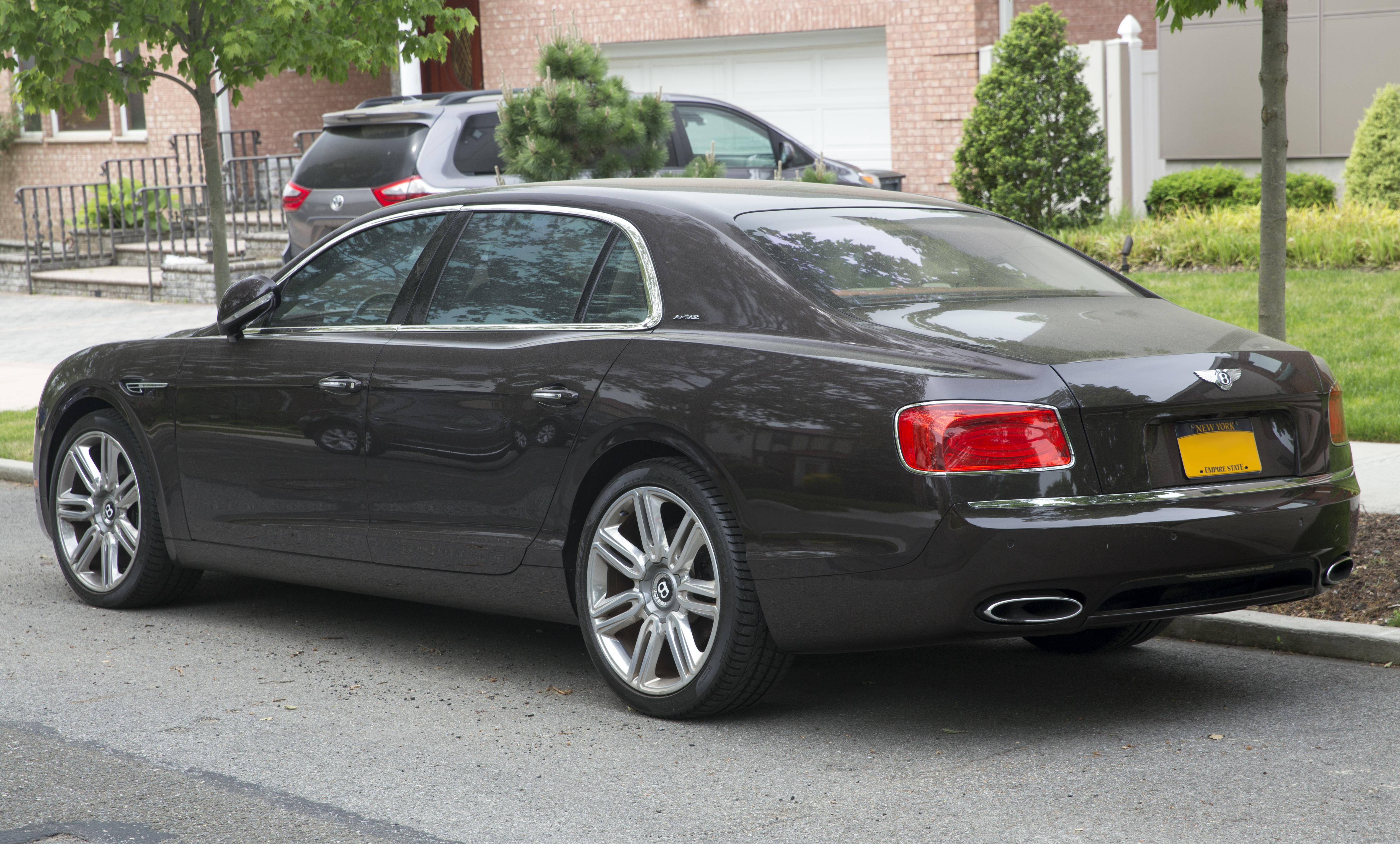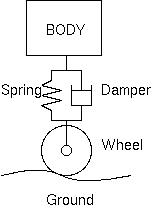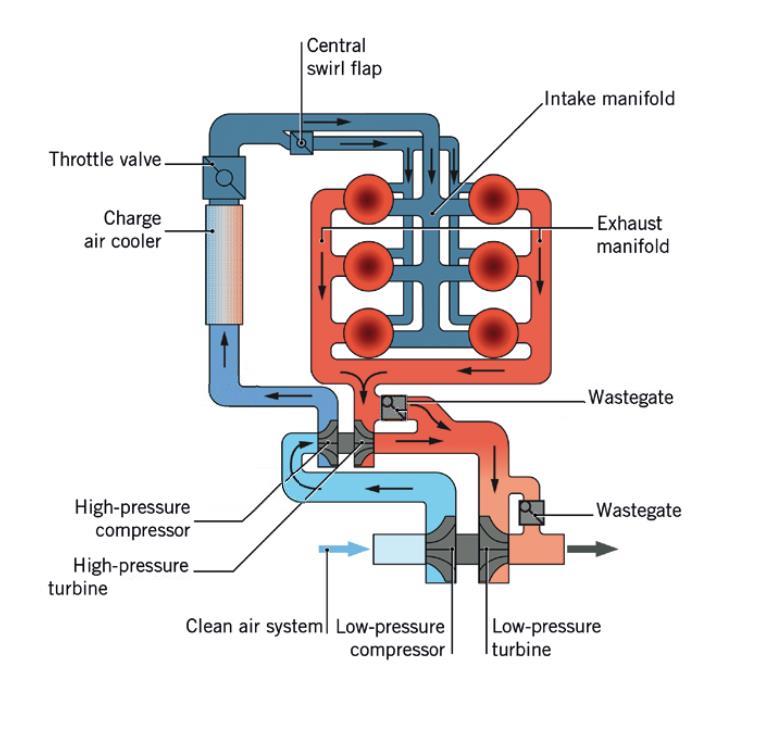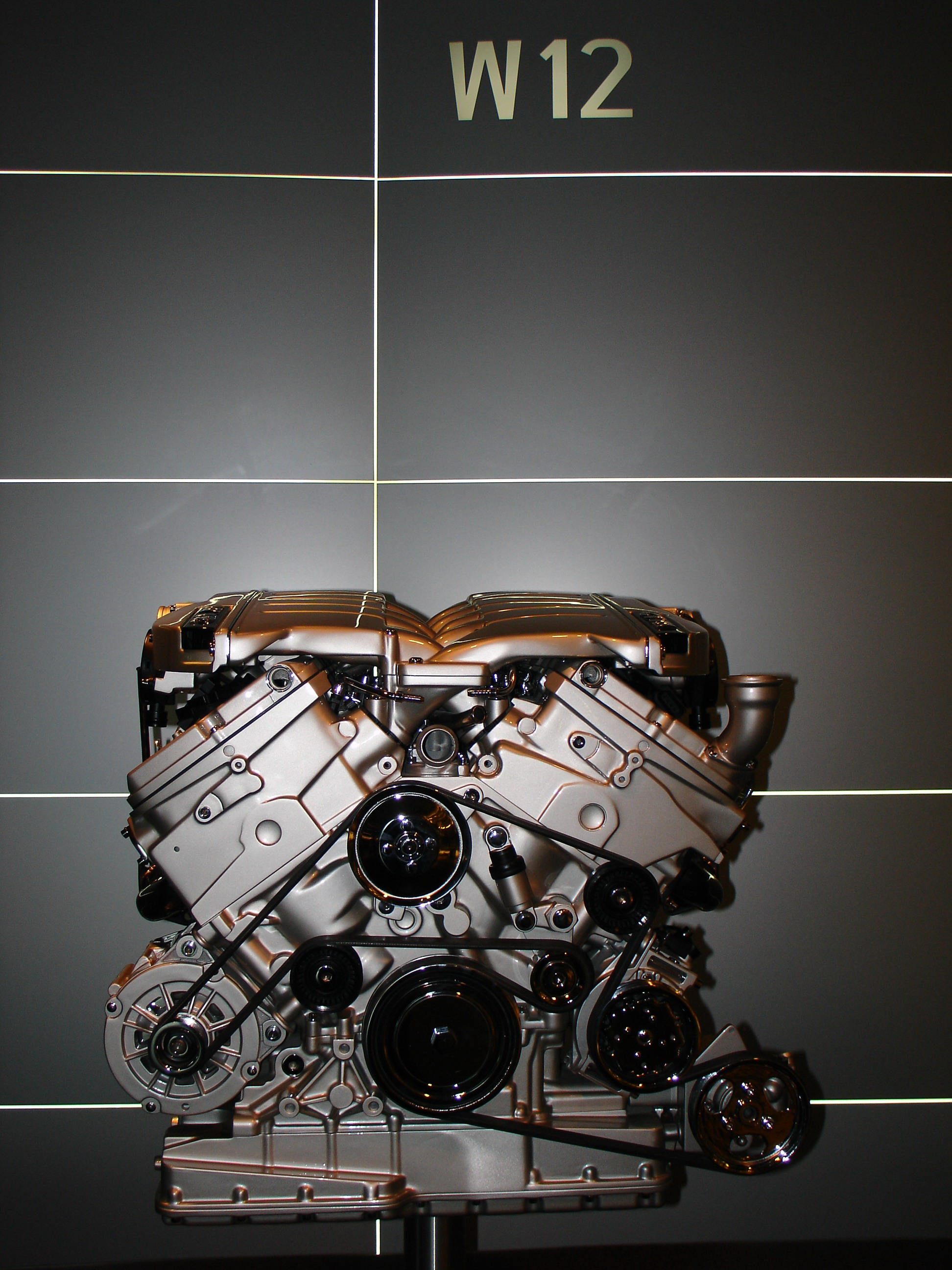|
Bentley Flying Spur (2005)
The Bentley Flying Spur is a full-sized high-performance luxury saloon produced by Bentley Motors Limited since 2005. It is the four-door grand tourer variant of the Bentley Continental GT coupé. The Flying Spur is handcrafted at Bentley's factory in Crewe, England. Each bespoke saloon takes more than 100 hours to assemble completely by hand. Briefly, due to lack of capacity at the Crewe factory upon the car's introduction, 1,358 units of the first generation Flying Spur destined for markets other than the United States and United Kingdom were built at Volkswagen's Transparent Factory in Dresden, Germany. This arrangement ended in early 2007, when all assembly works reverted to Crewe in England. __TOC__ First generation (2005–2013) Overview The first-generation Flying Spur was officially unveiled at the 75th Geneva Motor Show in March 2005. It had a twin-turbocharged W12 engine tuned to produce and torque of at 1,600–6,100 rpm. Torsen-based permanent all-wheel ... [...More Info...] [...Related Items...] OR: [Wikipedia] [Google] [Baidu] |
Bentley Motors
Bentley Motors Limited is a British designer, manufacturer and marketer of luxury cars and SUVs. Headquartered in Crewe, England, the company was founded as Bentley Motors Limited by W. O. Bentley (1888–1971) in 1919 in Cricklewood, North London, and became widely known for winning the 24 Hours of Le Mans in 1924, 1927, 1928, 1929 and 1930. Bentley has been a subsidiary of the Volkswagen Group since 1998 and consolidated under VW's premium brand arm Audi since 2022. Prominent models extend from the historic sports-racing Bentley 4½ Litre and Bentley Speed Six; the more recent Bentley R Type Continental, Bentley Turbo R, and Bentley Arnage; to its current model line, including the Flying Spur, Continental GT, Bentayga and the Mulsanne—which are marketed worldwide, with China as its largest market as of November 2012. Today most Bentley models are assembled at the company's Crewe factory, with a small number assembled at Volkswagen's Dresden factory, Germany, and w ... [...More Info...] [...Related Items...] OR: [Wikipedia] [Google] [Baidu] |
W12 Engine
A W12 engine is a twelve-cylinder piston engine where three banks of four cylinders are arranged in a W configuration around a common crankshaft. W12 engines with three banks of four cylinders were used by several aircraft engines from 1917 until the 1930s. A three-bank design was also used for an unsuccessful W12 engine which was intended to compete in Formula One in 1990. W12 engines are less common than V12 engines as only a handful of automobile manufacturers use them. The W12 engine has been produced by the Volkswagen Group since 2001. This four-bank engine – based on two VR6 engines with a common crankshaft – has only been used in flagship high performance car models produced under the Volkswagen Group. Aircraft engines The Napier Lion was a three-bank design (also called "broad arrow" design) W12 engine produced in the United Kingdom from 1917 to the late 1930s. It had a capacity of and produced . As well as use in various military and racing airplanes, the Lion ... [...More Info...] [...Related Items...] OR: [Wikipedia] [Google] [Baidu] |
Adaptive Suspension
An active suspension is a type of automotive suspension on a vehicle. It uses an onboard system to control the vertical movement of the vehicle's wheels relative to the chassis or vehicle body rather than the passive suspension provided by large springs where the movement is determined entirely by the road surface. Active suspensions are divided into two classes: real active suspensions, and adaptive or semi-active suspensions. While semi-adaptive suspensions only vary shock absorber firmness to match changing road or dynamic conditions, active suspensions use some type of actuator to raise and lower the chassis independently at each wheel. These technologies allow car manufacturers to achieve a greater degree of ride quality and car handling by keeping the tires perpendicular to the road in corners, allowing better traction and control. An onboard computer detects body movement from sensors throughout the vehicle and, using that data, controls the action of the active and semi-act ... [...More Info...] [...Related Items...] OR: [Wikipedia] [Google] [Baidu] |
All-wheel Drive
An all-wheel drive vehicle (AWD vehicle) is one with a powertrain capable of providing power to all its wheels, whether full-time or on-demand. The most common forms of all-wheel drive are: ;1x1 : All unicycles Reflecting one axle with one wheel capable of being powered. ; 2x2 : Some motorcycles and bikes Reflecting two axles with one wheel on each capable of being powered. ; 4×4 (also, four-wheel drive and 4WD): Reflecting two axles with both wheels on each capable of being powered. ; 6×6 (also, six-wheel drive and 6WD): Reflecting three axles with both wheels on each capable of being powered. ;8×8 (also, eight-wheel drive and 8WD): Reflecting four axles with both wheels on each capable of being powered. Vehicles may be either part-time all-wheel drive or full-time: ;On-demand (also, part-time): One axle is permanently connected to the drive, the other is being connected as needed ;Full-time (also, permanent): All axles are permanently connected, with or without a di ... [...More Info...] [...Related Items...] OR: [Wikipedia] [Google] [Baidu] |
Torsen
Torsen Torque-Sensing (full name Torsen traction) is a type of limited-slip differential used in automobiles. It was invented by American Vernon Gleasman and manufactured by the Gleason Corporation. Torsen is a portmanteau of Torque-Sensing. ''TORSEN'' and ''TORSEN Traction'' are registered trademarks of JTEKT Torsen North America Inc (formerly Zexel Corporation, formerly Gleason Power Systems). All Torsen differentials have their origin in the Dual-Drive Differential that was invented and patented by Gleasman in 1958. Use Torsen differentials can be used in one or more positions on a motor vehicle: * center—used to apportion torque appropriately between front and rear axles on an all-wheel drive vehicle. * rear—used to apportion torque appropriately between left and right sides in rear axles. This may be on either a rear-wheel drive or a four-wheel drive vehicle. * front—used to apportion torque appropriately between left and right sides in front axles. This may be on eith ... [...More Info...] [...Related Items...] OR: [Wikipedia] [Google] [Baidu] |
Torque
In physics and mechanics, torque is the rotational equivalent of linear force. It is also referred to as the moment of force (also abbreviated to moment). It represents the capability of a force to produce change in the rotational motion of the body. The concept originated with the studies by Archimedes of the usage of levers, which is reflected in his famous quote: "''Give me a lever and a place to stand and I will move the Earth''". Just as a linear force is a push or a pull, a torque can be thought of as a twist to an object around a specific axis. Torque is defined as the product of the magnitude of the perpendicular component of the force and the distance of the line of action of a force from the point around which it is being determined. The law of conservation of energy can also be used to understand torque. The symbol for torque is typically \boldsymbol\tau, the lowercase Greek letter ''tau''. When being referred to as moment of force, it is commonly denoted by . In ... [...More Info...] [...Related Items...] OR: [Wikipedia] [Google] [Baidu] |
Twin-turbo
Twin-turbo (not to be confused with a twincharger setup, which is a combination of a supercharger and a turbocharger) refers to an engine in which two turbochargers work in tandem to compress the intake fuel/air mixture (or intake air, in the case of a direct-injection engine). The most common layout features two identical or mirrored turbochargers in parallel, each processing half of a V engine's produced exhaust through independent piping. The two turbochargers can either be matching or different sizes. Types and combinations There are three types of turbine setups used for twin-turbo setups: * Parallel * Sequential * Series These can be applied to any of the five types of compressor setups (which theoretically could have 15 different setups): * Compound Compressors * Staged Compound Compressors * Staged Sequential Compressors * Parallel Sequential Compressors * Parallel Compressors Parallel A parallel configuration refers to using two equally-sized turbochargers which ... [...More Info...] [...Related Items...] OR: [Wikipedia] [Google] [Baidu] |
Volkswagen Phaeton
The Volkswagen Phaeton ( ) (''Typ'' 3D) is a full-size luxury sedan/saloon manufactured by the German automobile manufacturer Volkswagen, described by Volkswagen as their "premium class" vehicle. Introduced at the 2002 Geneva Motor Show, the Phaeton was marketed worldwide. Sales in North America ended in 2006 and global sales ended in 2016. The name Phaeton derives from Phaëton, the son of Phoebus (or Helios) in Greek mythology, by way of the phaeton auto body style and the type of horse-drawn carriage that preceded it. Production ended in March 2016 and an all-electric second generation was slated to be produced. Starting in April 2017, the ''Gläserne Manufaktur'' Dresden assembles the e-Golf instead. First and second series (2002) (GP0/GP1) Development The Phaeton was conceived by Ferdinand Piëch, then chairman of Volkswagen Group, who wanted a car that would surpass the German prestige market leaders, Mercedes-Benz and BMW, in part as a response to Mercedes' a ... [...More Info...] [...Related Items...] OR: [Wikipedia] [Google] [Baidu] |
Audi A8
The Audi A8 is a full-size luxury sedan manufactured and marketed by the German automaker Audi since 1994. Succeeding the Audi V8, and now in its fourth generation, the A8 has been offered with both front- or permanent all-wheel drive—and in short- and long-wheelbase variants. The first two generations employed the Volkswagen Group D platform, with the current generation deriving from the MLB platform. After the original model's 1994 release, Audi released the second generation in late 2002, the third in late 2009, and the fourth and current iteration in 2017. Noted as the first mass-market car with an aluminium chassis, all A8 models have used this construction method co-developed with Alcoa and marketed as the ''Audi Space Frame''. A mechanically upgraded, high-performance version of the A8 debuted in 1996 as the Audi S8. Produced exclusively at Audi's Neckarsulm plant, the S8 is fitted standard with Audi's quattro all-wheel drive system. The S8 was only offered with a sho ... [...More Info...] [...Related Items...] OR: [Wikipedia] [Google] [Baidu] |
Volkswagen Group D Platform
The Volkswagen Group D platform is a series of automobile platforms from the German concern Volkswagen Group. It has been used for large luxury automobiles. Originally used by the Audi marque, it is also latterly used by the Volkswagen Passenger Cars, and Bentley marques. D1/D11 The D1 (also known as the D11) platform was based on a stretched version of the Volkswagen Group C3/C4 platform: *Audi V8 (''Typ'' 44) (1988–1991) *Audi V8 (''Typ'' 4C) (1991–1994) D2 The D2 platform is an all aluminium monocoque, based on space frame principles, which helped to significantly reduce weight without being any less rigid. Audi AG refers to this type of construction as the "Audi Space Frame" (ASF). It is technically the first 'original' D platform. *Audi A8 (1994–2003) *Audi S8 (1996–2003) D3 The D3 platform, also employing an aluminium space frame, was used for the second generation Audi A8, A8L, and S8. *Audi A8 (2003–2010) *Audi S8 (2006–2009) D1 (VW Phaeton/Bentley ... [...More Info...] [...Related Items...] OR: [Wikipedia] [Google] [Baidu] |
Automatic Transmission
An automatic transmission (sometimes abbreviated to auto or AT) is a multi-speed transmission used in internal combustion engine-based motor vehicles that does not require any input from the driver to change forward gears under normal driving conditions. It typically includes a transmission, axle, and differential in one integrated assembly, thus technically becoming a transaxle. The most common type of automatic transmission is the hydraulic automatic, which uses a planetary gearset, hydraulic controls, and a torque converter. Other types of automatic transmissions include continuously variable transmissions (CVT), automated manual transmissions (AMT), and dual-clutch transmissions (DCT). An electronic automatic transmission (EAT) may also be called an electronically controlled transmission (ECT), or electronic automatic transaxle (EATX). A hydraulic automatic transmission may also colloquially called a " slushbox" or simply a "torque converter", although the latter term c ... [...More Info...] [...Related Items...] OR: [Wikipedia] [Google] [Baidu] |
Tiptronic
The modern usage of the automotive term manumatic denotes an automatic transmission that allows the driver to select a specific gear, typically using paddle-shifters, steering wheel-mounted push-buttons, or "+" and "-" controls on the gear selector. In the 1950s, the ''Automotive Products'' company in the United Kingdom produced an automated clutch system for automobiles called the ''Manumatic''. This system was installed in cars with a manual transmission, allowing them to be driven without needing to use a clutch pedal. Automatic transmissions Since the popularization of the hydraulic automatic transmission in the 1940s, many automatic transmissions have allowed indirect control of the gear selection, usually in the form of locking out higher gears. This was provided to allow engine braking on downhills or prevent the use of overdrive gears when towing and was typically achieved using positions such as "3", "2", and "1" on the gear selector. An automatic transmission with ... [...More Info...] [...Related Items...] OR: [Wikipedia] [Google] [Baidu] |







